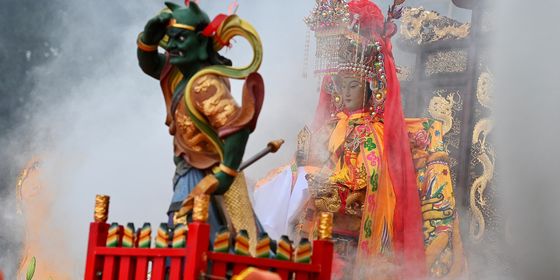The symbolism of China’s favorite color
Hailing from Hong Kong, I’m used to a certain reaction that residents of the Special Administrative Region have toward the color “red.” What does red signify, I sometimes ask? “Communism”, they almost invariably reply.
The answer is expected. In Hong Kong, “Red Background (红底),” is a pejorative word for people from the mainland, referring to the fact they live in a communist state. A symbol of communism and socialism globally, red is featured in not just the flag of the PRC but also Laos and Vietnam. For society without a history of communism, this has created, “Red Phobia”; Hong Kong is no exception.
Originally in Chinese culture, though, red carries a variety of positive connotations. Take a look at all the meaning of the color that, in spite politics, still plays an important role in the history, and culture of the Chinese.
The flag is, of course, the most “controversial” usage of red for the Chinese today. However, when the PRC adopted the flag in June 1949, according to the design of Zhejiang party member Zeng Liansong, the red was noted not to refer to communism specifically, but was the “color of revolution”; various patriotic songs further reference the flag being “stained the blood of martyrs who fought in the revolution,” including not just the PRC’s founding but the various wars and invasions in the 20th century.
The Spring Festival is definitely the season when red is ubiquitous: red envelopes, couplets, lanterns, and more. On other special occasions, like wedding or the birth of a new baby, red is also the primary color of the decorations.
The cultural obsession with red for celebration is due to its association with the sun. In the second-century BCE text Huainanzi‘s Astronomy (《淮南子·天文训》), there is the phrase, “月归而万物死,日至而万物生” (Yuè guī ér wànwù sǐ, rì zhì ér wànwù shēng), which means, “All things are dead under the moon; all things are alive under the sun.” By association, the ancient Chinese believed that red brought life to the world.
Red also has the meaning of loyalty. In history, when individuals formed allies with one another, they would out a drop of their blood in a bowl of water and drink it. This is so that if the opposite side betrays the agreement, they would be punished by the heavens. This practice was known as 歃血为盟 (shà xuè wéi méng, “drink blood to seal the oath”).
Last but not least, red commonly symbolizes luck. Back to the ancient beliefs: illnesses were traditionally thought to be brought by evil spirits, which had to be exorcised by chicken blood. Thus, red also carries a meaning of good fortune as it could drive evil away.
Though its meaning has been politicized, the lively and energetic color red still plays a role in traditional festivals, as well as symbolizing passion, courage, and even hospitality in modern contexts. More than just a color, it still plays a role in the identity of the Chinese.












